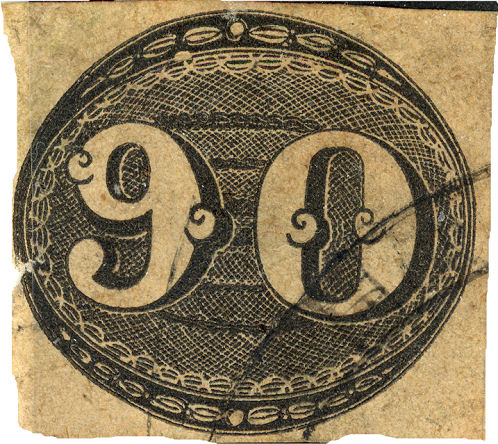
The 1843 (Bulls Eye) issue of Brazil - Fourth Forgery
Attribution: Unknown
Denominations: 30, 60 & 90 Reis
Of this forgery I have only the 90 Reis


Although there is undoubtedly a full set of this forgery it would appear to be rather scarce. The Rev Eareé possessed only a single example of the 60 Reis on which to base his description whilst I have but a single example of the 90 Reis on which to base mine.
Although there is good general agreement between us on most characteristics of this forgery there are points in the description where we diverge. The most significant difference relates to the configuration of the leaf pattern surrounding the white ball in the lower border of the stamp.
For the 60 Reis the Rev gives the configuration of the bunches of leave as 4 3 3 1 each side of the white ball whereas for the 90 Reis copy in my collection the pattern is 3 3 3 2 1 on the left and 3 3 3 3 1 on the right. The situation in regard to the 30Reis value must remain a point for conjecture
Denominations: 30, 60 & 90 Reis
Of this forgery I have only the 90 Reis

CHARACTERISTICS
- No frame line round the stamp.
- BAND A The white balls at both top and bottom of the stamp are considerably smaller than those of the genuine stamp .The one in the top border is flanked by bunches of leaves in the configuration 3 3 3 1 on either side of the ball like the genuine but in the lower border the configuration is3 3 3 3 2 1 on the left and 3 3 3 3 1 on the right
- BAND B consists of a series of long black dashes two or three deep, each outlined with a narrow white line and separated from the following group by a single large white dot.
- BAND C is composed of parallel groups of three black dashes considerably shorter than those of BAND B.
- BAND D Parallel black dashes in groups of two. This like the previous band although going all the way round the stamp is not visible in the interior spaces of the numerals.
- BAND E This is an additional band consisting of a wide band of short black dashes running above and below the centre line between the two numerals
- The background between BANDS B and C is the familiar pattern of black dots. Below the numerals these are arranged in oblique bands of three, above the numerals in bands of four. In other areas there is no discernable pattern.
- A perpendicular dropped downwards through the white ball in the top border would pass through the centre of the ball on the lower border.
Although there is undoubtedly a full set of this forgery it would appear to be rather scarce. The Rev Eareé possessed only a single example of the 60 Reis on which to base his description whilst I have but a single example of the 90 Reis on which to base mine.
Although there is good general agreement between us on most characteristics of this forgery there are points in the description where we diverge. The most significant difference relates to the configuration of the leaf pattern surrounding the white ball in the lower border of the stamp.
For the 60 Reis the Rev gives the configuration of the bunches of leave as 4 3 3 1 each side of the white ball whereas for the 90 Reis copy in my collection the pattern is 3 3 3 2 1 on the left and 3 3 3 3 1 on the right. The situation in regard to the 30Reis value must remain a point for conjecture